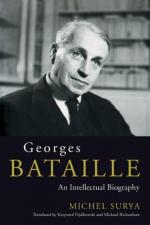|
This section contains 6,836 words (approx. 23 pages at 300 words per page) |

|
SOURCE: Hollywood, Amy. “Bataille and Mysticism: A ‘Dazzling Dissolution’.” Diacritics: A Review of Contemporary Criticism 26, no. 2 (summer 1996): 74-85.
In the following essay, Hollywood analyzes parallels between mysticism and the practice of writing in Bataille's works.
Within Georges Bataille's texts of the late 1930s and 1940s, in particular those later brought together in the tripartite Atheological Summa, he repeatedly suggests that his primary models for writing and experience are the texts of the Christian and non-Western mystical traditions (often represented, in Bataille, by women's writings) and those of Friedrich Nietzsche.1 Inner Experience opens with evocations of Nietzsche, and the final volume of the trilogy, On Nietzsche, is “devoted” to his work. References to mystical writings occur throughout Inner Experience and Guilty, and significant portions of both texts can be read as providing “guides” for inner experience analogous to the “itineraries” of Angela of Foligno (d. 1309) and Teresa of Avila...
|
This section contains 6,836 words (approx. 23 pages at 300 words per page) |

|


